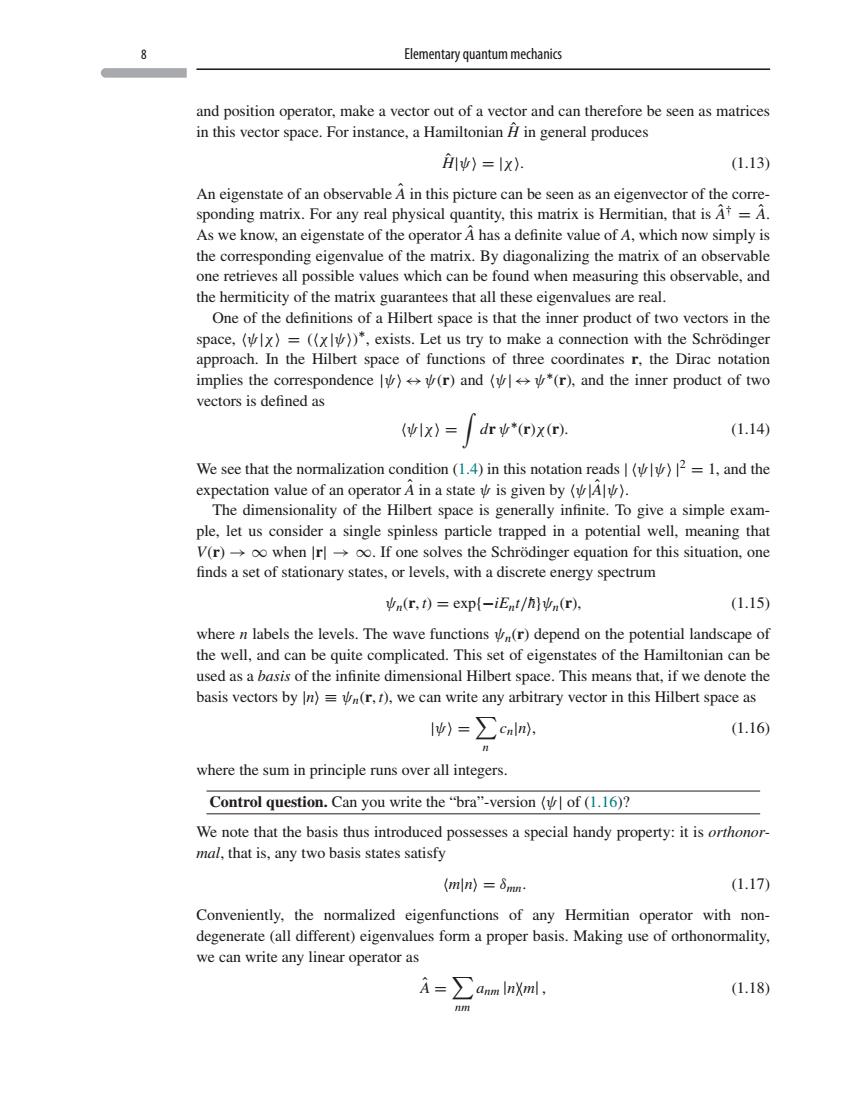正在加载图片...

Elementary quantum mechanics and position operator,make a vector out of a vector and can therefore be seen as matrices in this vector space.For instance.a Hamiltonian in general produces )=x) (1.13) An eigenstate of an observable A in this picture can be seen as an eigenvector of the corre sponding matrix.For any real physical quantity,this matrix is Hermitian.that is At=A As we know,an eigenstate of the operator A has a definite value of A,which now simply is the corre onding eige envalue of th trix.By diagonalizing the matrix of an obs 6 one retrieves all possible values which can be f ound when measuring this observable,an the hermiticity of the matrix guarantees that all these eigenvalues are real. One of the definitions of a Hilbert space is that the inner product of two vectors in the space.(vx)=((x))",exists.Let us try to make a connection with the Schrodinger approach.In the Hilbert space of functions of three coordinates r.the Dirac notation implies the pondence)(r)and ((r).and the inner product of tw vectors is defined as (1x)=dr*(r)x(r) 1.14) We see that the normalization condition(1.4)in this notation reads)=1,and the expectation value of an operator A in a state is given by (Al). The dimensionality of the Hilbert space is generally infinite.To give a simple exam- particle apped in a potential well,meaning that →oo when Irl→oo.If one s the Sch finds a set of stationary states,or levels,with a discrete energy spectrum vn(r.t)exp(-iEnt/vn(r). (1.15) where n labels the levels.The wave functions(r)depend on the potential landscape of states of the Hamiltonian can be we denote the basis vectors by In)=n(r,t).we can write any arbitrary vector in this Hilbert space as )=>cnln). (1.16 where the sum in principle runs over all integers. Control question.Can you write the"bra"-version of(1.16)? We note that the basis thus introduced possesses a special handy property:it isr mal,that is,any two basis states satisfy (mln)=8mn. (1.17) Conveniently.the normalized eigenfunctions of any Hermitian operator with non- degenerate(all different)eigenvalues form a proper basis.Making use of orthonormality. we can write any linear operator as A=∑ml (1.18)8 Elementary quantum mechanics and position operator, make a vector out of a vector and can therefore be seen as matrices in this vector space. For instance, a Hamiltonian Hˆ in general produces Hˆ |ψ=|χ. (1.13) An eigenstate of an observable Aˆ in this picture can be seen as an eigenvector of the corresponding matrix. For any real physical quantity, this matrix is Hermitian, that is Aˆ † = Aˆ. As we know, an eigenstate of the operator Aˆ has a definite value of A, which now simply is the corresponding eigenvalue of the matrix. By diagonalizing the matrix of an observable one retrieves all possible values which can be found when measuring this observable, and the hermiticity of the matrix guarantees that all these eigenvalues are real. One of the definitions of a Hilbert space is that the inner product of two vectors in the space, ψ|χ = (χ|ψ) ∗, exists. Let us try to make a connection with the Schrödinger approach. In the Hilbert space of functions of three coordinates r, the Dirac notation implies the correspondence |ψ↔ψ(r) and ψ|↔ψ∗(r), and the inner product of two vectors is defined as ψ|χ = dr ψ∗(r)χ(r). (1.14) We see that the normalization condition (1.4) in this notation reads | ψ|ψ |2 = 1, and the expectation value of an operator Aˆ in a state ψ is given by ψ|Aˆ|ψ. The dimensionality of the Hilbert space is generally infinite. To give a simple example, let us consider a single spinless particle trapped in a potential well, meaning that V(r) → ∞ when |r|→∞. If one solves the Schrödinger equation for this situation, one finds a set of stationary states, or levels, with a discrete energy spectrum ψn(r, t) = exp{−iEnt/h¯}ψn(r), (1.15) where n labels the levels. The wave functions ψn(r) depend on the potential landscape of the well, and can be quite complicated. This set of eigenstates of the Hamiltonian can be used as a basis of the infinite dimensional Hilbert space. This means that, if we denote the basis vectors by |n ≡ ψn(r, t), we can write any arbitrary vector in this Hilbert space as |ψ = n cn|n, (1.16) where the sum in principle runs over all integers. Control question. Can you write the “bra”-version ψ| of (1.16)? We note that the basis thus introduced possesses a special handy property: it is orthonormal, that is, any two basis states satisfy m|n = δmn. (1.17) Conveniently, the normalized eigenfunctions of any Hermitian operator with nondegenerate (all different) eigenvalues form a proper basis. Making use of orthonormality, we can write any linear operator as Aˆ = nm anm |nm| , (1.18)�